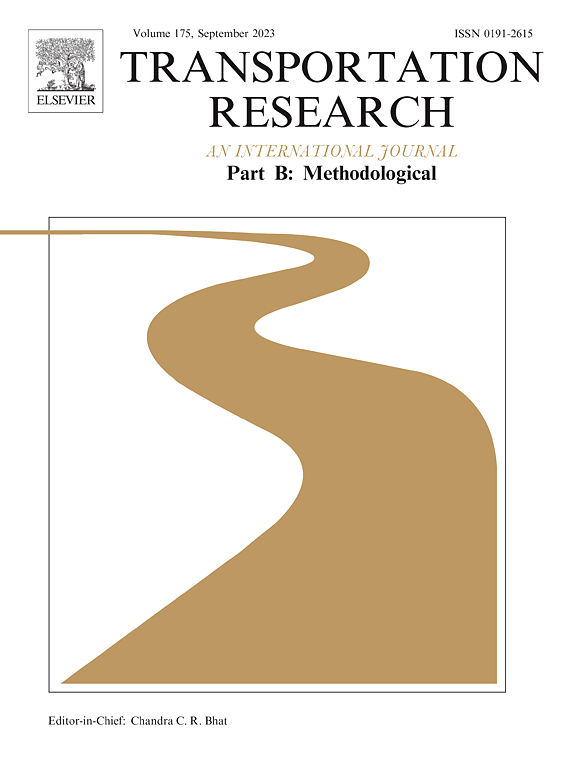基于部分互联车辆轨迹数据的信号网络实时车辆位置估计
IF 6.3
1区 工程技术
Q1 ECONOMICS
引用次数: 0
摘要
实时车辆位置估计对于各种交通应用至关重要,如行程时间估计、到达模式估计和自适应信号控制。现有的基于互联汽车的研究要么依赖于需要大量训练数据集的黑盒神经网络,要么依赖于基于汽车跟随模型的计算密集型时间连续运动模拟。然而,他们往往忽略了源车道上不同的车辆定位模式,源车道定义了网络边界并随机到达,而中间车道位于十字路口之间并接收上游排放的车辆。这些模式对于准确估计车辆位置至关重要。为了解决这些限制,本研究提出了一种通用的、完全分析的基于CV的车辆定位(CVVL)模型,该模型使用易于获得的部分CV轨迹数据来估计网络中信号车道内的车辆位置。该模型适用于任何信号配时、流量需求和CV渗透率,包括CVVL-S和CVVL-I两个子模型。CVVL-S子模型估计源车道上的车辆位置,由于随机到达,源车道上的车辆分布趋于相对均匀。相比之下,cvv1 - i子模型侧重于估计中间车道的车辆位置,其中来自不同上游车道的连续排放可能导致形成多个排,增加了车辆位置估计的复杂性。该模型将复杂的任务分解为三个连续的子问题:识别候选队列(CPs),估计每个CP中的车辆数量,以及确定每个CP内车辆的空间分布。使用VISSIM平台和真实世界的下一代模拟数据集,在各种交通条件、CV渗透率和兴趣时间下进行了大量的数值实验。结果表明,与同类方法相比,所提出的CVVL模型在查全率、查全率和F1分数上分别提高了0 - 45%、0 - 37%和4 - 34%。这些结果突出了该模型在提高各种下游应用的准确性和可靠性方面的潜力。本文章由计算机程序翻译,如有差异,请以英文原文为准。
Real-time vehicle location estimation in signalized networks using partial connected vehicle trajectory data
Real-time vehicle location estimation is essential for diverse transportation applications, such as travel time estimation, arrival pattern estimation, and adaptive signal control. Existing connected vehicle-based studies rely on either black-box neural networks requiring large training datasets or computationally intensive time-continuous movement simulations grounded in car-following models. However, they often overlook the distinct vehicle location patterns in source lanes, which define network boundaries and experience random arrivals, and intermediate lanes, situated between intersections and receiving traffic discharged from upstream. These patterns are critical for accurate vehicle location estimation. To address these limitations, this study proposes a generic and fully analytical CV-based vehicle location (CVVL) model for estimating vehicle locations within a signalized lane in a network using readily available partial CV trajectory data. The proposed model is applicable to any signal timing, traffic demand, and CV penetration rate and consists of two sub-models: CVVL-S and CVVL-I. The CVVL-S sub-model estimates vehicle locations in source lanes, where vehicle distribution tends to be relatively homogeneous owing to random arrivals. In contrast, the CVVL-I sub-model focuses on estimating vehicle locations in intermediate lanes, where sequential discharges from different upstream lanes can lead to the formation of multiple platoons, adding complexity to vehicle location estimation. The proposed model decomposes the complex task into three sequential sub-problems: identifying candidate platoons (CPs), estimating the number of vehicles in each CP, and determining the spatial distribution of vehicles within each CP. Extensive numerical experiments were conducted under various traffic conditions, CV penetration rates, and times of interest using the VISSIM platform and the real-world Next Generation Simulation dataset. The results demonstrate that the proposed CVVL model achieved improvements of 0–45 %, 0–37 %, and 4–34 % in precision, recall, and F1 score, respectively, compared with the competing method. These results highlight the model’s potential to enhance the accuracy and reliability of various downstream applications.
求助全文
通过发布文献求助,成功后即可免费获取论文全文。
去求助
来源期刊
CiteScore
12.40
自引率
8.80%
发文量
143
审稿时长
14.1 weeks
期刊介绍:
Transportation Research: Part B publishes papers on all methodological aspects of the subject, particularly those that require mathematical analysis. The general theme of the journal is the development and solution of problems that are adequately motivated to deal with important aspects of the design and/or analysis of transportation systems. Areas covered include: traffic flow; design and analysis of transportation networks; control and scheduling; optimization; queuing theory; logistics; supply chains; development and application of statistical, econometric and mathematical models to address transportation problems; cost models; pricing and/or investment; traveler or shipper behavior; cost-benefit methodologies.

 求助内容:
求助内容: 应助结果提醒方式:
应助结果提醒方式:


